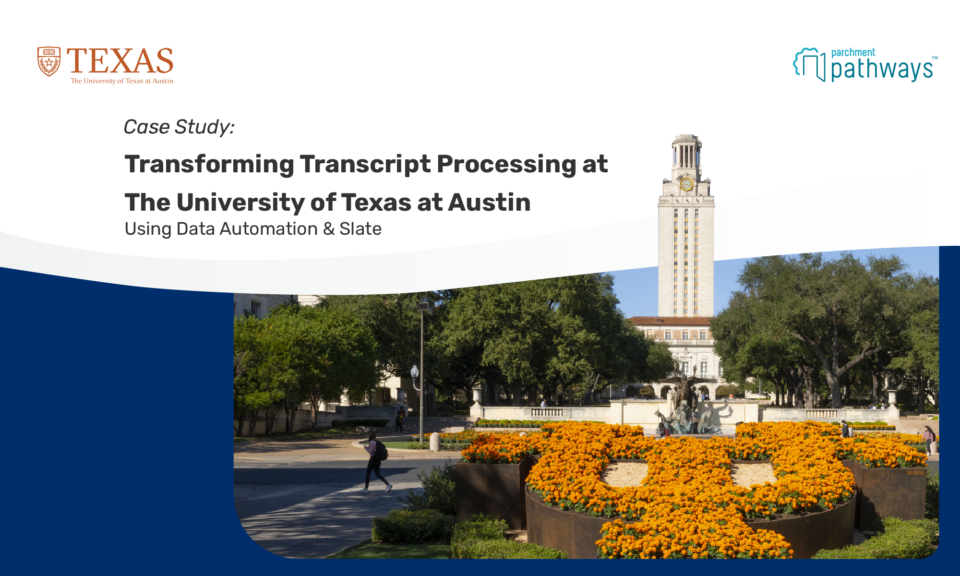
Learn how transcript automation with Parchment Receive Premium + Data Automation, integrated with Slate, is helping The University of Texas at Austin cut transcript processing costs by 50% and reduce the staff time needed to process transcripts by 70%.

Challenges
- Inefficient, tedious, manual data entry
- Integrating multiple systems, including Slate
- Concerns over accuracy & quality of data

Solution
- Parchment Receive Premium With Slate Integration
- Parchment Data Automation
Results
- An efficient solution for processing 50,000 transcripts
- Fully integrated workflows with Slate
- Quality OCR data extraction, with 95%+ accuracy
Background
At the height of COVID, The University of Texas at Austin made the decision to transition to test-optional for first-year students. With test scores no longer part of the admissions criteria, additional data points were needed to assist them in evaluating prospective students. They settled on a predictive GPA using data extracted from the transcript. The shift from test scores to relying solely on the transcript presented several challenges. It was a herculean effort to manually input the information from transcripts, requiring a team of over 100 people. This wasn’t sustainable, so the Admissions team decided to explore an OCR solution that alleviated the tedious work related to manual transcript data entry.
Finding the Right Partner
There is no shortage of OCR vendors in higher education. In fact, The University of Texas at Austin began their OCR journey with another vendor entirely. Ultimately, it didn’t work out the way they had hoped. Allison Radke, Assistant Director of Admissions, compares their experience with Parchment to their previous vendor by saying, “The first vendor was not successful. The communication and follow through weren’t what we needed or expected. We decided to continue to pursue OCR with another partner. We had a previous relationship with Parchment and we knew we could trust them. We were impressed by the demo and liked that their solution could integrate with our other Admissions systems, including Slate.”
Implementing Data Automation With Slate
When considering scaling their operations, it was critical to integrate Data Automation with Slate, The University of Texas at Austin’s application platform. Matthew Barsalou, Senior Information Technology Manager, describes why this was critical, “Before, we were manually pulling up the transcript and had to do quite a bit of training and quality assurance. It was taxing and time consuming. We were assessing all the transcripts we received, spending valuable time and energy on students who may not complete their application. We needed to focus our time and attention on students who actually completed their application in Slate.” But, how did they do it? Tom Picklesimer, Slate Solutions Manager, describes the integration workflow, “We have a series of directories on the Slate SFTP. We export a query with the ZIP files of the PDFs that includes an indexed CSV. Parchment’s Data Automation solution consumes those files. It then gets sent back to us via SFTP in a CSV format. We read that back and drop it into the “Profile Courses” tab in Slate.”
Initially wary of the length of time it could take, The University of Texas at Austin walked away impressed at how straightforward the implementation process was. Allison Radke says, “Implementation took about 6-8 weeks. Within 6 weeks we were working with test data in the system before rolling out fully.”
“Data Automation has been a game-changer for us. If we didn’t have a tool like this, we would be in a lot of pain.”

Allison Radke
Assistant Director of Admissions, The University of Texas at Austin
A Solution That Works
One of the most common concerns around OCR technology is the accuracy of the data. After all, if intense quality assurance is required on each data set, the efficiency is lost. Tom Picklesimer highlights the accuracy of Data Automation, “It’s been extremely accurate. We can really rely on this data. It’s been about 95% accurate. If there are errors, they are readily visible. It’s been a night and day difference from what we were doing in the previous cycle. We are receiving around 50,000 transcripts so when you’re talking about that kind of scale, it’s nothing short of remarkable.”
Allison describes the stark contrast from their previous process to their current state by saying, “We’ve been able to move from a team of 100 temporary staff to a team of around 30. We have a consistent process that can scale. Data Automation has been a game-changer for us. If we didn’t have a tool like this, we would be in a lot of pain.”
Exceptional Customer Service
Of course, implementing the right technology is just the initial phase. Supporting the technology and the institution are necessary elements for ongoing success. Tom describes his experience working with the Data Automation team, “Everyone has been phenomenal. If there were any challenges, it was resolved in very short order.” Allison Radke was equally impressed, “Customer service has been exceptional. The team has been extremely responsive and patient. They made sure everything was working according to our desires. It was night and day compared to our previous vendor. They took the time to explain what was possible and what wasn’t.”
Benefits with Parchment
50% reduction in transcript processing costs
95% accuracy in extracting transcript data
Integrations with third party apps such as Slate

70% less staff time needed to process transcripts
Scalable solution that can meet growing demand

About The University of Texas at Austin
- Top 10 “Public University” by U.S. News & World Report
- Founded in 1883, now enrolls more than 50,000 students, across 19 colleges and schools, and offers 150+ undergraduate degree programs
- No. 6 among U.S. universities for research financed by the National Science Foundation
There’s always more to learn.
Ready to feel the power of Parchment?
I’m a student or a learner
OrderI work at an institution or business
Get a Demo
